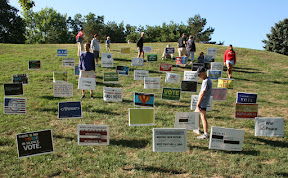 Thursday and Friday, December 4 and 5
Thursday and Friday, December 4 and 5UPDATE: For some great pictures of the trip, one of our shipmates on the cruse, Mike Nelson, just posted some of his great pictures at http://tinyurl.com/a5f9tc.
Just realized, there are only two more full days on the ship--and that except for one excursion to an island in Gatun Lake in the Panama Canal, no more hiking.
Today, our only excursion off the ship today is a zodiac ride around an Island looking for brown footed boobies (birds), blue footed boobies, brown pelicans, and magnificent frigate birds. Saw some common brown pelicans, a lot of brown footed boobies-including nests built on the rocks with chicks, and even more frigate birds--some males with the big read neck pouch.
When we head to the canal we're told" the rest of the day's schedule will be determined by the Panama Canal Administration (they control when we get to enter the canal).
Panama Canal
Juxtaposition of going through the Panama Canal after over a week of intense exposure to nature is a little shocking. You can consider the Panama Canal as the high tech of the early 20th Century. It was cutting edge when it was built.
 While the current canal was built to tame nature, this canal succeeded where the French failed because it worked with nature a lot more than the French attempt. The French had attempted to build a canal at sea level--cutting straight through the The Isthmus of Panama. The French also hadn't considered what to do with the major river that crossed the path of their canal. The US plan used locks to raise the canal 83 feet above sea level and used the water from the river (yes they damned it) as a major part of the canal and for operating the locks.
While the current canal was built to tame nature, this canal succeeded where the French failed because it worked with nature a lot more than the French attempt. The French had attempted to build a canal at sea level--cutting straight through the The Isthmus of Panama. The French also hadn't considered what to do with the major river that crossed the path of their canal. The US plan used locks to raise the canal 83 feet above sea level and used the water from the river (yes they damned it) as a major part of the canal and for operating the locks.
Since I live on the Mississippi, about two miles from three different sets of locks, I didn't think I'd be that interested in going through the Panama Canal. I was wrong--it was fascinating. The locks are smaller than the Soo Locks between Lake Superior and Lake Huron but when you are going through them, the appear huge. We were in a relative small ship. Freighters that are "Panamax" size only have about 2 feet on either side.
While we were going north (toward the Atlantic), in one set of locks we passed a Russian military ship. It turned out that it was the first Russian military ship to use the Panama Canal.
About halfway through the canal, we stopped for the morning at the Smithsonian's Tropical Research Insitute on an Island in the middle of Lake Gatun. We split into three groups and walked through the rainforest (up and down hills) with guides from the Insitute. Our guide was doing research on bullit ants. So we learned a lot about ants.
Tomorrow morning we take the bus from Colon to Panama City and fly back to Miami.








































